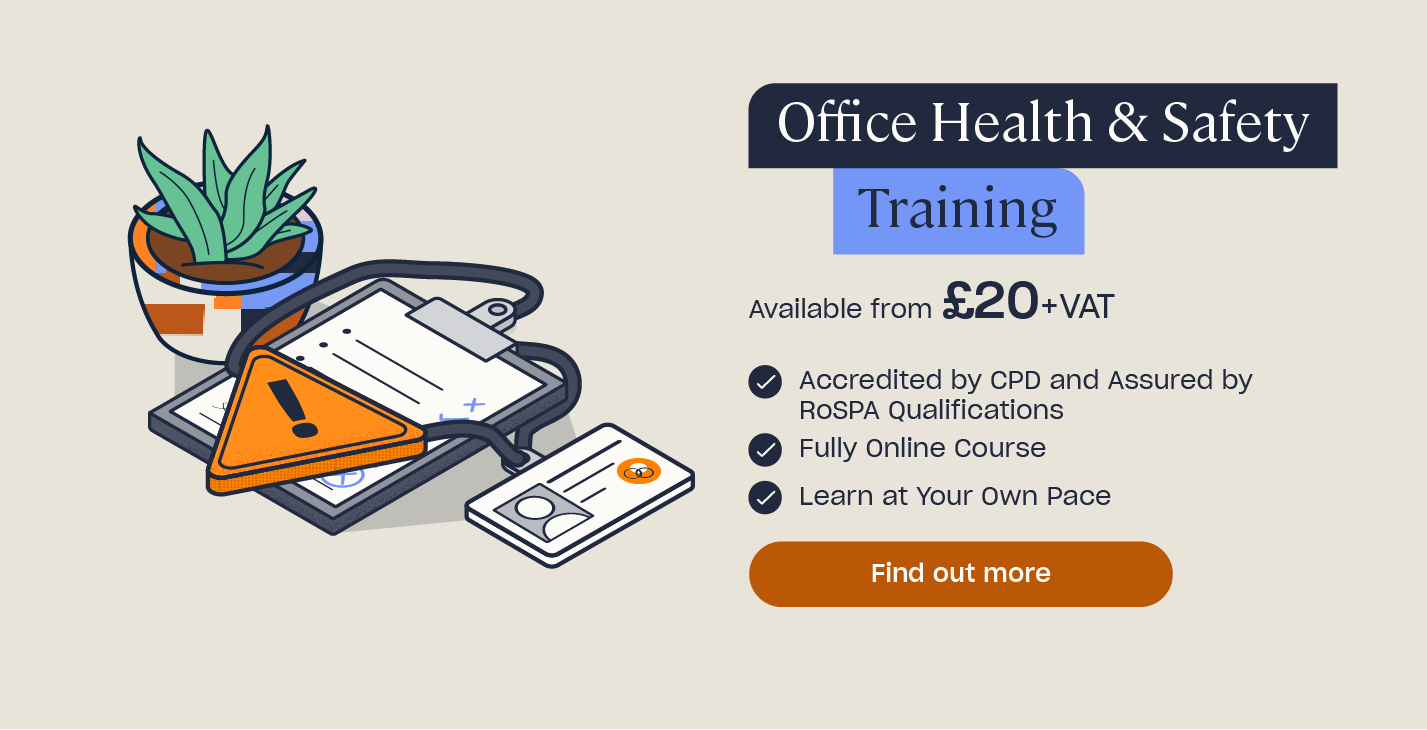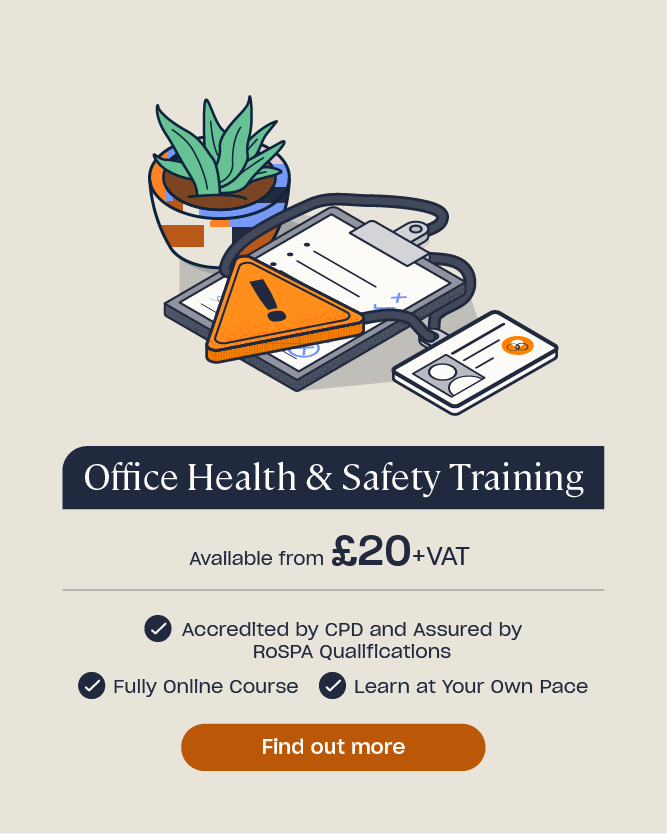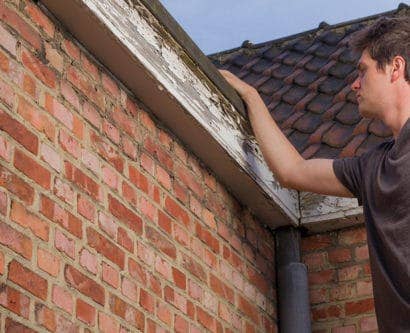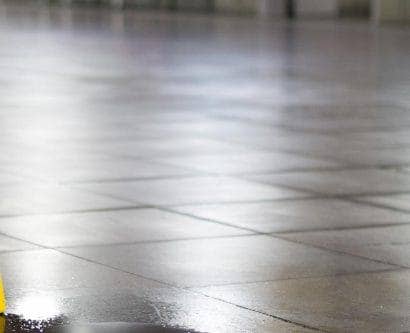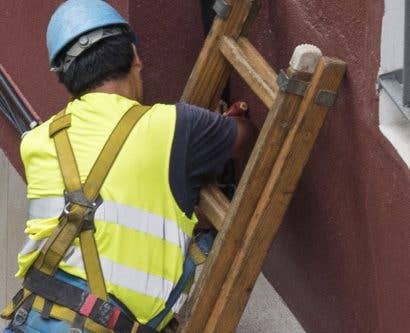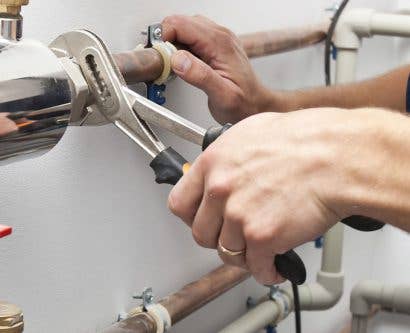Office Hazard Checklist for Health & Safety
All office workplaces have the potential to present risks to your health and safety, even if you don’t immediately realise it. Take a look around your office now – what can you see that may cause an accident? Do you know what the hazards are and what you can do to prevent them? Use the following checklists to conduct a general workplace inspection and assess whether you need to make any changes:
Slips and Trips
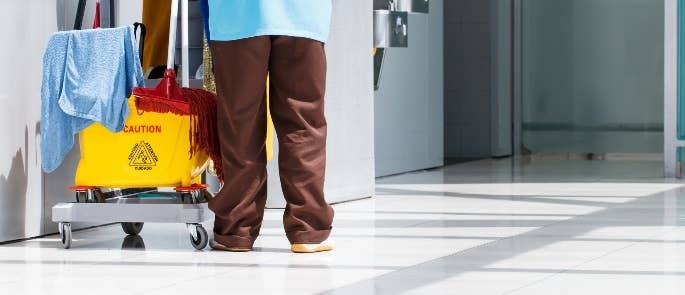
Slips and trips are the most common cause of injuries to workers and are one of the most preventable types of accidents. They are usually as a result of human factors, meaning that they are caused by people, usually due to poor housekeeping or poor risk perception. Here are the most common hazards to look out for and their solutions:
| Hazard | Solution |
|---|---|
| Mud, leaves or water on the floor. | Use ‘wet floor’ signs in bad weather to warn people of the hazard. |
| Floors left wet from cleaning. | Arrange for cleaning to be done outside of working hours and use ‘wet floor’ signs. |
| Loose door mats, rugs and carpets. | Make sure mats and rugs are secured to the floor or built-in to the flooring. |
| Spillages. | Ensure everyone cleans up spills, like tea, coffee or cleaning chemicals straight away. |
| Trailing electrical cables. | Keep cables out of walkways and use cable ties to hold them together. |
| Uneven walkways, steps and ramps. | Highlight the edges of uneven surfaces with yellow tape to warn people of the hazards. |
| Poor lighting. | Install good lighting in all areas. |
| Poor housekeeping and objects in walkways. | Keep corridors and walkways free from obstructions and ensure people tidy up after themselves. |
You can learn more with our Slips, Trips and Falls online training course.
Fire Safety
Workplace fires can be catastrophic for any business and can be near-impossible to fully recover from. In an office you must follow the correct fire safety procedures so that risks are minimised and you know how to safely escape should a fire ever break out. Here are the most common hazards to look out for and their solutions:
| Hazard | Solution |
|---|---|
| Overheated electrical equipment. | Always switch equipment off when not in use and remove it from use immediately if it gets too hot or begins to smell of burning. |
| Matches, gas hobs and lighters. | Only use open flames well away from flammable materials. |
| Smoking. | Take care when smoking and discarding smoking materials to ensure that they don’t set light to flammable materials. |
| Sources of fuel, including stacks of paper, cardboard, packaging, textiles and hazardous substances. | These act as sources of fuel for a fire so ensure excess materials are discarded safely and away from sources of ignition. |
| Obstructed escape routes and fire doors. | Good housekeeping ensures clear corridors and walkways meaning people can escape more efficiently in case of fire. |
| Faulty fire-fighting equipment. | Check regularly to ensure that fire extinguishers and blankets etc. are present and in-date. Also check that emergency lighting is working. |
| Irregular fire drills. | Practice fire drills should be performed at least annually and all employees must be familiar with the sound of the alarm, how to operate it and how to react if the alarm sounds. |
You can learn more with our Fire Safety online training course.
Electrical Safety

Electricity is a useful and necessary part of working in an office, but it can also cause major injuries or even result in death. Whilst you may not be working directly with electricity in an office, it’s likely that the majority of your equipment is powered by it, making it essential to be aware of the risks electricity can cause. Here are the most common hazards to look out for and their solutions:
| Hazard | Solution |
|---|---|
| Damaged cables. | Check wires regularly for damage or fraying and take the equipment out of use straight away if you see anything wrong. |
| Loose or badly wired plugs. | Report any defects to a manager so that the plug can be fixed. |
| Overloaded sockets and extension cables. | Never plug one extension cable into another as you may overload the electricity supply. |
| Overheated equipment. | Equipment that gets too hot or starts to smell of burning must be switched off and removed from use. |
| Electrical equipment near water. | Avoid switching on equipment near to the sink as water will conduct electricity. |
| Equipment being used incorrectly. | Always use equipment for the job it was intended. |
| Equipment with an out of date PAT label. | This means the equipment hasn’t been recently checked for safety. Report it to your manager so that checks can be performed. |
You can learn more with our Electrical Safety online training course.
Falls from Height
Falls from height can happen anywhere and from any height. The trip hazard height necessary to cause an injury doesn’t need to be as high as the top of a ladder: it could even happen from head height. In an office you may be required to put up a display, access a high-up cupboard or change a light bulb: all activities that, without good working at height practices (e.g. the correct use of a ladder or stepladder) can lead to major fall injuries. Here are the most common hazards to look out for and their solutions:
| Hazard | Solution |
|---|---|
| Over-reaching from a ladder. | Ensure the ladder faces the direction of work. |
| A ladder toppling over. | Always place the ladder on a firm, level surface and non-slippery floor. |
| Standing on chairs/tables etc. | Always use appropriate access equipment as furniture is unsuitable and unstable. |
| Dropping items onto people. | Never carry more items up a ladder than you can safely manage. You should always have one hand free at all times to grip the ladder. |
| A stepladder collapsing. | Ensure the stepladder is fully open and the locking devices are engaged before using. |
You can learn more with our Working at Height online training course.
Manual Handling

Manual handling is any action involving physical effort to move or support an object or person by lifting, pushing, pulling, manoeuvring, steadying, carrying or transporting. Physical injuries are common if you don’t carry out these actions correctly and pay attention to your manual handling weight limits. Here are the most common hazards to look out for and their solutions:
| Hazard | Solution |
|---|---|
| Moving office furniture. | Ask for help with lifting things or get a removal company to move large objects. Don’t try to move anything outside of your ability as it may cause injury. |
| Carrying heavy books and files. | Break the load down into smaller, lighter loads and take more journeys to avoid straining your arms and back. |
| Lifting heavy/bulky objects onto shelving. | Aim to store heavier items at waist height to avoid the need for reaching up or bending down. |
| Lowering heavy/bulky objects from high-up storage. | Store heavy items lower down at waist height or use a suitable, sturdy ladder to access things higher up. |
| Regularly carrying a laptop computer. | Ensure you have a suitable carry case to avoid putting strain on your back, neck or arms. |
| Pushing a trolley. | Don’t overload the trolley so that it’s too heavy. Push rather than pull where possible, too. |
You can learn more with our Manual Handling online training course.
Display Screen Equipment (DSE)
Display screen equipment (or DSE) includes equipment such as desktop computers, laptops, tablets, smart phones, television screens and video monitors. In an office it’s likely that you use DSE for the majority, or entirety, of your working day. However, spending too long using DSE can pose many risks to your health. Here are the most common hazards to look out for and their solutions:
| Hazard | Solution |
|---|---|
| Repetitive movements. | Avoid repeating the same actions too many times by placing your keyboard, mouse and monitors in a comfortable position. You should be able to use them without stretching or leaning. |
| Uncomfortable working postures. | Make sure that your chair is stable and at the right height so your feet are flat on the floor and eyes level with the top of your screen. Leaning, reaching or stretching for long periods can cause aches and pains. You should also ensure your DSE is properly set up if you use a standing desk. |
| Incorrect screen settings and set-up. | Keep the screen clean, legible and tilted so you can see it without glare from lighting. Ensure the colours, contrast and font size are comfortable for you to read. |
| Long periods of work without breaks. | Always take regular breaks to stretch, change posture and rest your eyes. |
| A poor working environment. | There needs to be enough space on, under and around your desk for comfortable and regular movement. |
You can learn more with our Display Screen Equipment (DSE) online training course.
Stress and Mental Health

Stress can be a significant cause of illness and has the ability to trigger mental, physical, behavioural and emotional problems that affect how you feel, think and act. Stress and other mental health problems often develop when the demands of work are too high or too low. Here are the most common hazards to look out for and their solutions:
| Hazard | Solution |
|---|---|
| An unclear job role. | Talking to your manager and finding out exactly what you should – and shouldn’t – be doing will help you to focus and prioritise. |
| Too many or too few work demands and responsibilities. | Delegate responsibilities, ask for deadlines or ask for more tasks to do if you feel like you’re getting bored or frustrated. |
| Work beyond your capability. | Ask your manager for clarification of what is expected and explain that you need help with the task at hand. |
| Boring, uninspiring work tasks. | Take regular breaks to rest your mind and try to break tasks up into smaller chunks so you’re not doing the same thing for a prolonged period of time. |
| Difficult work relationships. | Change your seating arrangements or ask your manager to mediate so that problems can be resolved. |
| A poor working environment. | Ensure lighting, heating and ventilation are suitable, add plants to your desk and ensure you have enough space to work comfortably. |
| Long working hours. | Discuss flexible working or altering your start/finish times to ensure working overtime doesn’t become the norm. |
You can learn more with our Mental Health Awareness online training course.
Further Resources:
- Office Health and Safety Quiz
- DSE Workstation Assessment and Checklist
- Slips, Trips and Falls Quiz
- Health and Safety When Working with Computers: An Office Guide
- Workplace Health & Safety Quiz
- What Are the Key Differences Between Flammable and Combustible Materials?
- Office Health and Safety Training


